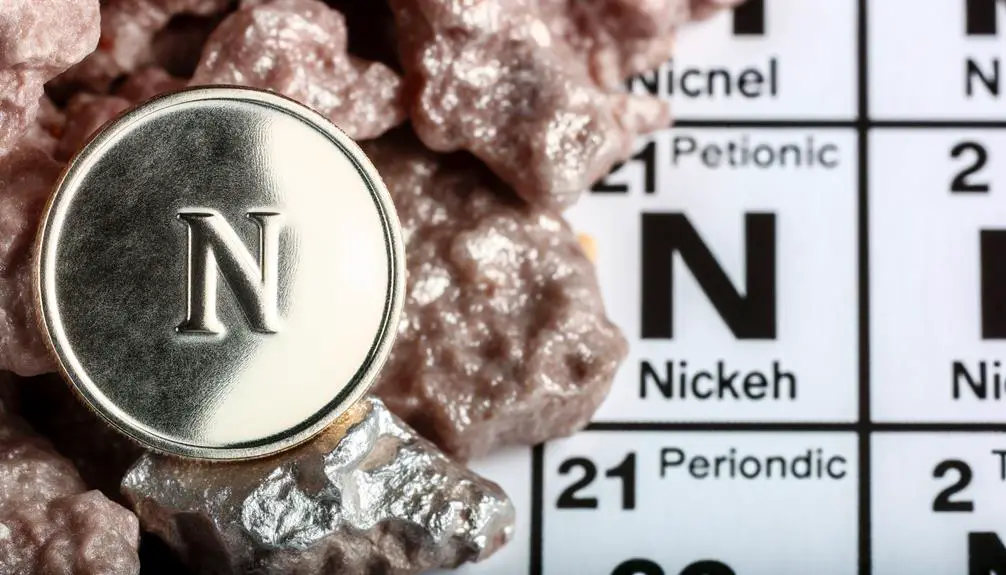Ni Symbol: What Element Does It Represent?
The symbol 'Ni' denotes the element Nickel, discovered by Axel Fredrik Cronstedt in 1751. Notable for its high melting point of 1,455°C and robust corrosion resistance, Nickel is a critical component in numerous industrial applications.
It is essential in stainless steel production, aerospace engineering, and electronic devices. Additionally, Nickel's abilities to form diverse alloys and facilitate electroplating make it invaluable.
However, its extraction has significant environmental impacts, including air and water pollution. Recycling efforts aim to mitigate these effects.
For a deeper understanding of Nickel's properties and uses, further exploration is warranted.

Key Takeaways
- Ni is the chemical symbol for the element Nickel.
- Nickel was discovered by Axel Fredrik Cronstedt in 1751.
- Nickel is known for its excellent corrosion resistance and high melting point.
- It is widely used in stainless steel, batteries, and aerospace components.
- Nickel plays a crucial role in environmental sustainability through efficient recycling efforts.
Discovery of Nickel

The element nickel, symbolized as Ni, was first isolated and identified by Swedish chemist Axel Fredrik Cronstedt in 1751. Cronstedt discovered nickel while attempting to extract copper from an ore known as kupfernickel (nickel arsenide).
Through meticulous experimentation, he observed that the ore did not yield copper but instead produced a distinct metal. By conducting a series of reduction and purification processes, Cronstedt succeeded in isolating this new element. His discovery marked a significant advancement in the field of chemistry, as nickel's unique characteristics were previously unrecognized.
Cronstedt's work laid the groundwork for subsequent studies, establishing nickel as a valuable material for various industrial applications. His precise methodology exemplifies the rigorous scientific approach necessary for elemental discovery.
Properties of Nickel
Nickel exhibits a range of remarkable properties, including excellent corrosion resistance, high melting point, and significant ferromagnetism.
With a melting point of 1,455°C, nickel is highly suitable for high-temperature applications. Its remarkable resistance to oxidation and corrosion is attributed to the formation of a stable oxide layer on its surface. Nickel's ferromagnetic properties, persisting up to its Curie temperature of 358°C, make it integral in magnetic and electronic applications.
Additionally, nickel demonstrates excellent mechanical properties, such as high tensile strength and ductility. This combination of properties makes nickel a versatile element in various industrial applications, including alloy formation, electroplating, and battery production. Its chemical stability further enhances its utility in harsh environments.
Nickel in Daily Life

Nickel plays an essential role in daily life through its incorporation in various household items, particularly stainless steel products due to its corrosion resistance and durability.
Additionally, nickel alloys are vital in industrial applications, such as in the manufacturing of aerospace components, batteries, and electronic devices.
The versatility and resilience of nickel-based materials underscore their widespread utility across multiple sectors.
Everyday Uses of Nickel
In modern applications, nickel is essential due to its corrosion resistance, high melting point, and ability to alloy with other metals. This element plays a pivotal role in the production of rechargeable batteries, particularly in nickel-cadmium (NiCd) and nickel-metal hydride (NiMH) configurations, which power a range of consumer electronics.
Additionally, nickel is utilized in the electroplating industry to provide a protective and aesthetically pleasing coating for various metal objects. Household items such as kitchen utensils, coins, and bathroom fixtures frequently contain nickel due to its durability and resistance to tarnish.
Moreover, nickel's magnetic properties are harnessed in the production of permanent magnets used in various domestic and industrial applications. Nickel's versatility ensures its widespread utilization in everyday life.
Nickel Alloys in Industry
Utilizing nickel alloys in industrial applications greatly enhances material performance owing to their exceptional strength, corrosion resistance, and high-temperature stability. These characteristics make nickel alloys indispensable in various sectors.
Key industrial applications include:
- Aerospace Engineering: Nickel-based superalloys are vital for jet engines and gas turbines, offering durability in extreme conditions.
- Chemical Processing: Nickel alloys resist corrosive environments, making them ideal for equipment in chemical plants.
- Power Generation: High-temperature stability of nickel alloys is vital for components in nuclear reactors and fossil fuel power plants.
The incorporation of nickel into alloys not only extends the lifespan of industrial equipment but also guarantees operational efficiency and safety. This underscores nickel's pivotal role in advancing modern industry.
Industrial Uses of Nickel
Widely employed in various industrial sectors, nickel plays a critical role in the production of stainless steel, batteries, and corrosion-resistant alloys. In stainless steel manufacturing, nickel enhances resistance to oxidation and corrosion, while also improving ductility and toughness. Nickel-cadmium and nickel-metal hydride batteries utilize nickel for its electrochemical properties, providing efficient energy storage solutions. Additionally, nickel is integral to the creation of corrosion-resistant alloys used in harsh environments, such as chemical plants and marine applications.
| Application | Industrial Benefit |
|---|---|
| Stainless Steel Production | Enhanced corrosion resistance, ductility, toughness |
| Battery Manufacturing | Efficient energy storage |
| Corrosion-Resistant Alloys | Durability in harsh environments |
| Chemical Plant Equipment | Increased lifespan and reliability |
Nickel's versatility underscores its indispensability in modern industry.
Nickel Alloys

Renowned for their exceptional mechanical properties and resistance to corrosion, nickel alloys are foundational materials in numerous high-performance applications. The versatility of nickel alloys stems from their ability to maintain structural integrity under extreme conditions.
Key characteristics and applications include:
- High-temperature stability: Nickel alloys, such as Inconel, are used in jet engines and gas turbines due to their ability to withstand temperatures exceeding 1000°C without significant degradation.
- Corrosion resistance: Alloys like Monel are employed in marine environments and chemical processing industries where resistance to seawater and acidic conditions is essential.
- Strength and durability: Nickel-chromium alloys, such as Nichrome, are utilized in heating elements and electrical resistors because of their strength and stability over extended periods.
These properties make nickel alloys indispensable in advanced engineering solutions.
Environmental Impact of Nickel
The extraction and processing of nickel have significant environmental consequences, including habitat destruction due to mining activities and the release of pollutants into air and water systems.
These impacts require rigorous regulatory oversight and advanced technological solutions to mitigate adverse effects.
Additionally, recycling and sustainability efforts are essential in reducing nickel's environmental footprint and promoting more eco-friendly practices within the industry.
Mining and Habitat Destruction
Nickel mining operations frequently result in significant habitat destruction, adversely affecting biodiversity and ecosystems. The extraction processes often necessitate large-scale deforestation and soil disruption, leading to a cascade of environmental impacts.
Key consequences include:
- Loss of Biodiversity: The removal of vegetation and soil layers disrupts local flora and fauna, leading to the decline or extinction of species.
- Soil Erosion: Mining activities exacerbate soil erosion, reducing land fertility and increasing sedimentation in nearby water bodies.
- Altered Hydrology: The disruption of natural landforms alters water flow patterns, affecting aquatic ecosystems and local water availability.
These repercussions underscore the need for stringent environmental management practices to mitigate the ecological footprint of nickel mining operations.
Air and Water Pollution
Emissions from nickel mining and refining processes contribute substantially to air and water pollution, introducing harmful contaminants such as sulfur dioxide and heavy metals into the environment. Sulfur dioxide, a byproduct of smelting nickel ores, leads to acid rain, which damages ecosystems and corrodes structures.
Additionally, heavy metals like nickel, cobalt, and lead can contaminate water sources, posing risks to aquatic life and human health. These contaminants bioaccumulate in organisms, disrupting biological systems and entering the food chain.
The leaching of tailings and waste materials further exacerbates pollution, causing long-term ecological damage. Effective monitoring and regulatory measures are essential to mitigate these adverse environmental impacts, ensuring sustainable mining practices and protecting natural resources.
Recycling and Sustainability Efforts
Implementing strong recycling programs and sustainable practices is essential in mitigating the environmental impact of nickel production. Recycling nickel reduces the need for primary extraction, thereby decreasing associated ecological disturbances.
Sustainable practices in nickel production can be enhanced through various strategies:
- Resource Efficiency: Utilizing advanced technologies to maximize recovery rates from nickel-containing products reduces waste and conserves raw materials.
- Energy Management: Employing renewable energy sources and optimizing energy consumption at nickel processing facilities to minimize carbon emissions.
- Environmental Protection: Implementing stringent regulations to control emissions and effluents, safeguarding air and water quality in surrounding areas.
These measures collectively contribute to a more sustainable nickel industry, balancing economic growth with environmental stewardship.
Conclusion
To sum up, Nickel, symbolized as Ni, stands as an exemplar of industrial usefulness and everyday necessity. Its unearthing, characteristics, and diverse uses highlight its quiet omnipresence.
Nonetheless, as Nickel dutifully aids humanity, the environmental consequences of its extraction and utilization hint at a paradoxical irony: the very element that simplifies contemporary living also adds to its ecological challenges.
This illustrates the contradiction of advancement, where functionality and environmental responsibility continuously contend.






